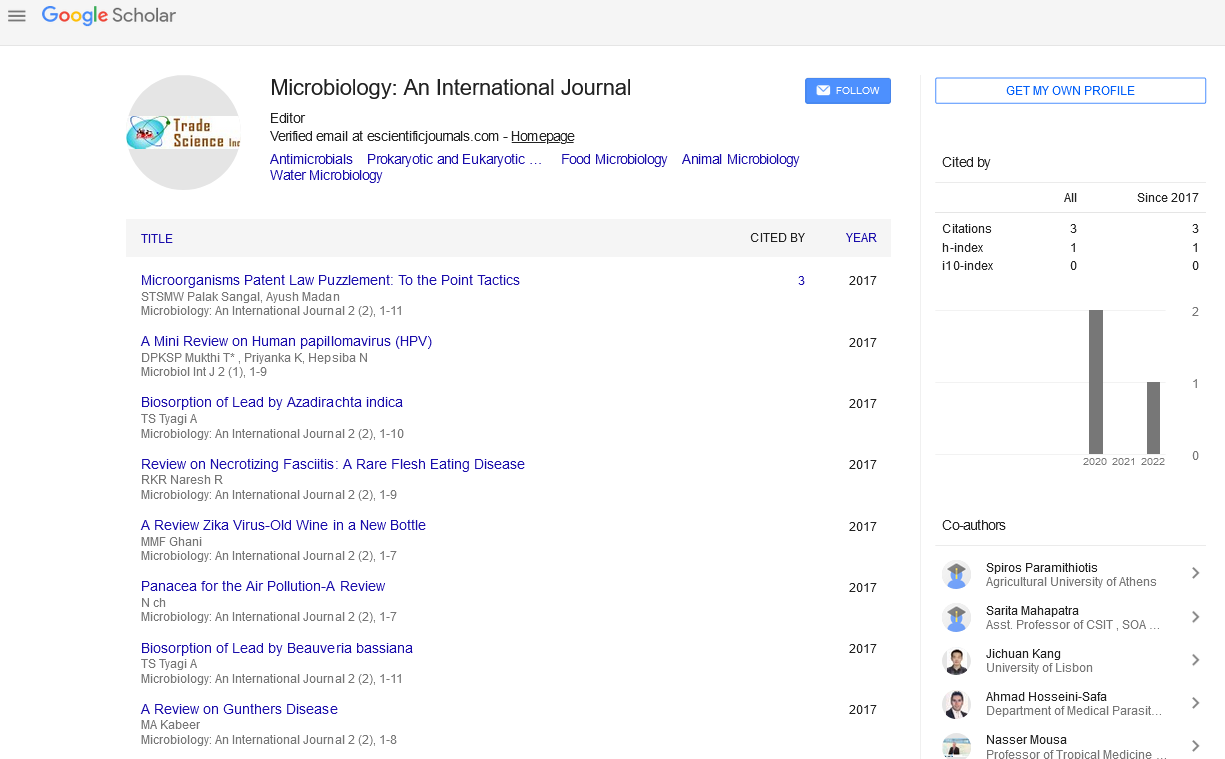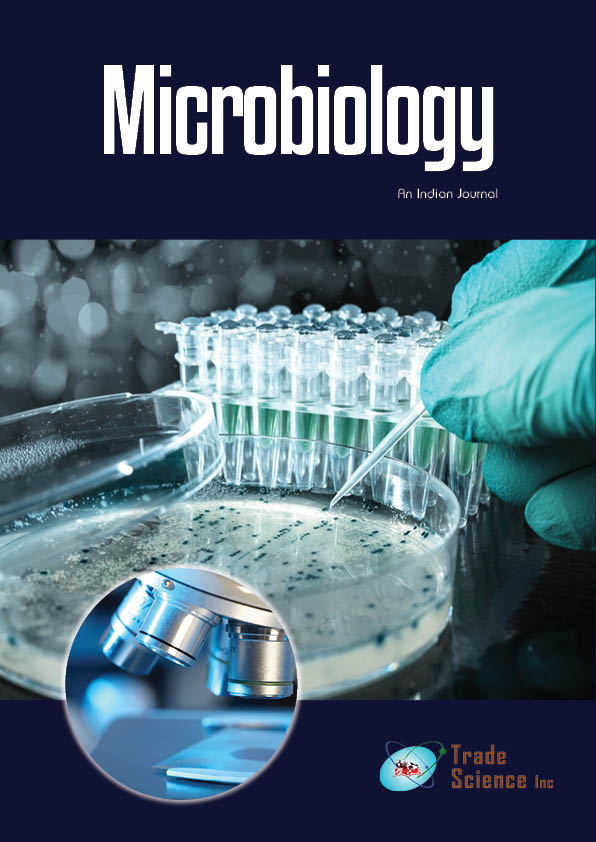Review
, Volume: 4( 1) DOI: 10.37532/tsmy.2022.4(1).137Bacteriocins' Prevalence and their Relationship to Pathogenicity
- *Correspondence:
- Lekhashri Pandit
Department of Microbiology,University of Calicut, Kerala, India; Email: P.lekhashri@gmail.com
Received: 02-Feb-2022, Manuscript No. TSMY-22-56954; Editor assigned: 03-Feb-2022, PreQC No. TSMY-22-56954(PQ); Reviewed: 17-Feb-2022, QC No. TSMY-22-56954; Revised: 21-Feb-2022, Manuscript No. TSMY-22-56954(R); Published: 28-Feb-2022, DOI: 10.37532/tsmy.2022.4(1).137
Citation: Pandit L. Bacteriocins' Prevalence and their Relationship to Pathogenicity. Microbiol Int J. 2022;4(1):137.
Abstract
Bacteriocins throw a light on minimising this problem in public and animal health in the hunt for an alternate treatment to combat antimicrobial resistance. Bacteriocins are peptides made by bacteria that stop other bacteria, fungi, parasites, and viruses from growing. Lactic acid bacteria (LAB) create bacteriocins, which can be used to replace antibiotics and avoid bacterial resistance. LAB and bacteriocins are antimicrobials and probiotics used in veterinary medicine. Bacteriocins also have an immunomodulatory impact, which is extremely important. The improvements in using bacteriocins in animal production and veterinary care are highlighted in this overview, which also highlights their biological roles. The exposure of target cells to antimicrobial agents generated considerable changes in essential cellular elements, as indicated by Fourier-transform infrared spectroscopy combined with principal component analysis. Our findings suggest that bacteriocins produced by food-related LAB against oral LAB may be uncommon, but they require further exploration because they can be effective antimicrobials when discovered.
Keywords
Bacteriocins, Antimicrobials, Lactic acid Bacteria, Probiotics, Immunomodulation.
Introduction
Bacteriocins are heat-stable antimicrobial peptides produced via ribosomal synthesis. In the late-exponential to early-stationary development phases, both Gram-positive and Gram-negative bacteria, as well as archaea, release antimicrobial peptides extracellularly. Bacteriocins have antibacterial efficacy against bacteria, fungi, parasites, viruses, and even natural resistant formations such bacterial biofilms. Lactic acid bacteria (LAB) are a Grampositive bacterium that comes in a variety of shapes and sizes [1].
They are classed based on the properties of glucose fermentation, cell shape, sugar utilisation capacity, and optimal growth temperature range. As a result, the Lactobacillus, Pediococcus, Leucononstoc, and Streptococcus genera were classified as a core group in this classification system. Aerococcus, Alloiococcus, Carnobacterium, Dolosigranulum, Enterococcus, Lactococcus, Lactosphaera, Melissococus, Oenococcus, Tetragenococcus, Vagococcus, and Weissella are among the genera that have grown in number as a result of molecular biological approaches. LAB inhibits the growth of harmful microbes, degrades mycotoxins, and has a probiotic effect, according to various researches. LABS are abundant in nature and have a symbiotic relationship with higher creatures [2]. They've been found in dairy products, meat, fruits, and vegetables, among other things. They're also found in the mucous membranes of man's and animals' respiratory, intestinal, and other anatomical places, as well as in plants, wastewater, soil, and manure. Bacteriocins have been utilised as food preservatives because of their capacity to prevent germs that could be hazardous to people's health. They are safe to eat and have no effect on food quality or safety.
Bacteriocins developed by LAB have also had a considerable impact in other industries, such as cosmetics and human and veterinary medicine. Bacteriocin-producing bacteria have been employed as probiotics in the diet or drinking water of pigs, poultry, and fish in animal production, resulting in enhanced growth rates. LABS are one of the most important kinds of bacteria that help people and animals. As a result, the focus of this study is on highlighting how LAB bacteriocins are being used as antimicrobials, probiotics, and immunomodulators in animal agriculture and veterinary care [3].
Dental plaque is a biofilm that forms naturally on the teeth and is made up of roughly 100 bacteria species that are part of the oral cavity's complex ecosystem. Interactions between these bacterial species are the key etiological agents of oral infectious illnesses such as dental caries, gingivitis, and periodontitis, from the early phases of colonisation to the production of mature supragingival and subgingival plaque. Dental caries is a multifactorial bacterial illness characterised by acid demineralization of tooth enamel as a result of streptococci of the mutans group growth [4].
Specific Gram-negative bacterial infections cause gingivitis and periodontitis in the majority of people. Infections like this destroy connective tissue and cause the underlying alveovar bone and periodontal ligament to break down, causing the teeth to fall out. In addition, several systemic disorders, including as pneumonia and cardiovascular disease, have been linked to mouth bacteria in recent years [5].
Conclusion
Given their close phylogenetic kinship, LAB was a pleasant surprise. The bacitracin's efficacy against the three oral streptococci was strong when tested in inhibition assays. Exposure of target cells to antimicrobial agents generated considerable changes in essential cellular elements, as indicated by Fourier-transform infrared spectroscopy combined with principal component analysis. Our data suggest that bacteriocins produced by food-related LAB against oral LAB are uncommon, but they merit further exploration since, if discovered, they can be effective antimicrobials. Food; oral; Streptococcus; bacteriocin; lactic acid bacteria. Introduction Probiotics, which are described as "living microorganisms that impart a health benefit on the host when provided in suitable proportions," have become a prominent focus of lactic acid bacteria (LAB) research in the previous two decades. Despite the fact that probiotics have been shown to have a multitude of health-promoting properties, the gastrointestinal system has been the primary focus of study thus far. Probiotics have received little attention when it comes to dental health. This is, however, beginning to shift. Dental plaque is a biofilm that forms naturally on the teeth and is made up of a variety of microorganisms that contribute to the oral cavity's complex ecosystem. Oral infectious illnesses such as dental caries, gingivitis, and periodontitis are caused by interactions between various bacterial species, which occur from the early stages of colonisation through the production of mature supragingival and subgingival plaque. Dental caries is a multifactorial bacterial illness characterised by acid demineralization of tooth enamel caused by streptococci of the mutans group growth. Specific Gram-negative bacterial infections cause gingivitis and periodontitis in the majority of people. Infections like this destroy connective tissue and cause the underlying alveovar bone and periodontal ligament to break down, causing the teeth to fall out. In addition, several systemic disorders, including as pneumonia and cardiovascular disease, have been linked to mouth bacteria in recent years.
References
- Barreteau H, Bouhss A, Fourgeaud M, et al. Human-and plant-pathogenic Pseudomonas species produce bacteriocins exhibiting colicin M-like hydrolase activity towards peptidoglycan precursors. J Bacteriology. 2009;191(11):3657-3664.
- Abriouel H, Franz CM, Omar NB, et al. Diversity and applications of Bacillus bacteriocins. FEMS Micro Rev. 2011;35(1):201-232.
- Fernandez M, Godino A, Príncipe A, et al. Effect of a Pseudomonas fluorescens tailocin against phytopathogenic Xanthomonas observed by atomic force microscopy. J Biotech. 2017;256:13-20.
- Mittal R, Aggarwal S, Sharma S, et al. Urinary tract infections caused by Pseudomonas aeruginosa: a minireview. J Infec Pub Health. 2009;2(3):101-111.
- Smith K, Martin L, Rinaldi A, et al. Activity of pyocin S2 against Pseudomonas aeruginosa biofilms. Antimicro Agents Chemo. 2012;56(3):1599-1601.
Indexed at, Google Scholar, Cross Ref
Indexed at, Google Scholar, Cross Ref
Indexed at, Google Scholar, Cross Ref
Indexed at, Google Scholar, Cross Ref

